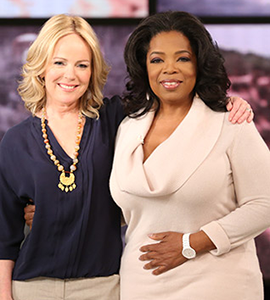Frame by Frame
Growing up, Dani Shapiro always felt caught in her mother’s viewfinder-until she found the strength to break free.
When I was six months old, my mother brought me from our suburban New Jersey home to a television studio in Manhattan. I was placed in a high chair, and an actress playing my mother spooned baby food into my mouth. My mother watched nervously from the wings, where two backup babies were waiting in case I spat out the food-but I didn’t. I gurgled and smiled and ate the strained peaches. I was a natural, apparently. When it was over, I had become the Beech-Nut baby. (Here is a video of me in a Beech-Nut orange juice ad.)
The week the commercial was due to air, my grandfather-my father’s father-died suddenly in his home on Central Park West. The following day, at his funeral, my grandmother suffered a massive stroke. As the shocked, grieving family gathered in my grandmother’s room at Beth Israel hospital, my mother arranged for a television to be wheeled to the foot of her bed. The scene, as I imagine it, is in black-and-white: My parents and aunts and uncles, all younger than I am now, turn to watch the last few minutes of the evening news with Walter Cronkite. Then, right on schedule, Cronkite signs off, and I appear. My round baby head fills the screen.
That’s Dani! my mother says loudly into my grandmother’s ear. Look, Mom, there on TV-that’s your granddaughter!
A welcome diversion, no doubt. A small moment of cheer in a grim situation. A baby on television-a widow, hovering near death. My unshaven uncles, my hollow-eyed aunts, my father-the oldest son-pacing the room, wild with grief. And then there is my mother: tall and lovely, her dark hair impeccably coiffed. Almond-shaped eyes, her generous mouth outlined and blotted a deep, dark red. Look, there she is-there’s Dani! She wants everyone to see: the doctors, nurses, orderlies. I am her crowning achievement, her late-in-life only child. This is the first of many times that she will ascribe to me magical powers: Someday she will tell me, in all seriousness, that the glimpse of me on television may have helped to save my grandmother’s life.
The camera formed a bridge between my mother and me. It was a rickety bridge, and crossing it was often fraught with danger, but it was also our deepest, most intoxicating connection. Never did my mother love me more than when she was looking at an image of me. And never did I more powerfully feel her love. As a grown woman, sometimes I would call my mother to tell her about somewhere I had just been. An elegant party, perhaps. How did you look? my mother would ask eagerly. What did you wear? Were there pictures?
My mother didn’t think much of child actors or their stage mothers. She had been an advertising executive before she married my father, and she often told the story of a child who had stamped her foot during an audition and shouted, “Mommy, there’s a spot on my Mary Jane!” As with many of my mother’s stories, it was hard to know what she actually felt. Her words-without exception-seemed rehearsed. She was profoundly composed: The precise way she crossed her legs, or raised an eyebrow, or tilted her head was done with a great deal of awareness. She must have told me the Mary Jane story a dozen times, and yet I was never quite sure what to make of it. She seemed to be implying that she would never let her daughter become a child actor.
How, then, to explain that a few years after the Beech-Nut commercial, I became the symbol for another iconic American brand when I was chosen to be the Kodak Christmas poster child? Just as with the Beech-Nut commercial, my mother acted a bit puzzled, as if she hadn’t been the one carting me around to auditions. She preferred to make it seem as if the advertising world had been banging on our door and it would have been rude and withholding not to answer.
The Kodak billboard stretched across the width of Grand Central station, huge and illuminated, high above the heads of rush-hour commuters: me, age three-no longer a generic baby who might be replaced by another baby. Now I was fully recognizable. I was blonde, blue-eyed, quizzical; an all-American symbol of Yuletide cheer. We were observant Jews, so religious that my father’s colleagues on the New York Stock Exchange had nicknamed him Rabbi. My mother often trotted out the story of the Kodak poster in a way that made me feel oddly ashamed. And there was Dani, wishing the entire world a Merry Christmas!
Reality invariably disappointed my mother. From the time that I was a little girl, I sensed the divide between how she imagined a future occasion-whether an afternoon in the park, an evening at the opera, a dinner party, a walk around the block-and how that occasion turned out. She had a tableau in her mind, a series of images, and anything that deviated from those images was a blot on her good time. But the camera-the camera could capture a moment: evidence that life was really as she fantasized it to be. See? We were happy. We were beautiful and special. We loved each other without fail.
I have a memory of my mother descending the stairs of our home, gliding as regally as a queen, holding her head high. She is dressed to go out for the evening. She is impossibly elegant, a New Jersey housewife who belongs on Fifth Avenue and never lets us forget it. (She could have married the French businessman who ran Chanel, she told me more than once.) On this night she is wearing Bonnie Cashin-a classic American designer who suits my mother’s dark, rangy style. A cloud of Norell perfume drifts around her-I can smell it still. She is on her way to the theater, but before she goes, she finds her camera and hands it to the baby-sitter. “Take our picture,” she commands. She stands next to me, a thin, graceful arm draped across my small shoulders. She smiles a careful, picture-perfect smile. Not too wide, just enough teeth showing. I am in pajamas-fresh-scrubbed, sweet-breathed, ready for bed. I am her pretty girl, her one-and-only. I also produce a camera-ready smile. How I look is desperately important to my mother, and I don’t want to disappoint her.
Over the years of my childhood, my mother’s dreams shifted and changed-perhaps self-protectively. Her vision of herself as a career girl-about-town, a cross between Marlo Thomas and Mary Tyler Moore, quickly receded behind the privet hedges of suburbia. She joined committees, did volunteer work. But always she held herself apart. She saw herself as smarter, better educated, more sophisticated than our neighbors. In truth, she may have been all these things. But she had contempt for the other women, and it showed.
She had writerly aspirations and drove into the city regularly to take fiction workshops and television-script-writing courses. She wrote a series of spec scripts for Hawaii Five-O and The Partridge Family-the sound of the keys of her Smith-Corona typewriter pounding well into the night. She sent these scripts by registered mail to Hollywood and waited for replies that never came-not even rejection slips. She didn’t let her disappointment show. Instead, she turned her attention to writing a children’s book, which she titled Yes, Mary Ann, the World Is Round. She hired the famous children’s photographer who had done the Kodak poster to shoot the illustrations, and cast me-age five-as the angelic Mary Ann. The book was never published. The photographs remain. I am in a pale-yellow flannel nightgown, sitting up in bed, playing with dolls. I am lying flat on my back, doing my best imitation of sleep.
Eventually, the sound of the typewriter keys stopped. My mother moved on to other ventures-each more unrealistic than the last. And always, I wound up in front of a camera, posing as everything I was not: a rah-rah cheerleader, a well- adjusted, popular girl. I am standing in our driveway, an awkward adolescent, modeling a necklace from my mother’s latest line of tennis jewelry. A gold ball the size of a gumdrop hangs around my neck. In the center of the ball is a small sapphire in the shape of an eye. keep your eye on the ball is the motto. Next, I am in profile, shot from the back, a small terry-cloth towel embroidered with no sweat, baby! wrapped around my neck. My mother stages an elaborate fashion show in our backyard. Dozens of neighborhood ladies sit on folding chairs in the hot summer sun and politely clap as I parade around the pool, showing off my mother’s latest T-shirt line. I sense that they are all weary of her-and perhaps me, by proxy.
I was embarrassed by my mother’s quixotic dreams, even as I hoped they would somehow come true. I was all knotted up in her aspirations-her vision of us as a mother-daughter winning team-and when her businesses failed, one after another, I felt as if I had failed as well.
The message was this: If reality disappointed my mother, and photographs pleased her, then I needed to make myself as two-dimensional, flat, and picture perfect as I could. Don’t frown, darling. Your face might freeze that way. When I went off to college, I might have finally been able to cast off this way of being like a second skin. I might have become a serious student, found a passion, and stuck with it. Instead, I sought the comfort of what I already knew-and what I had been told I was good at. I started auditioning for television commercials during my freshman year.
Auditions led to advertising work-York Peppermint Patties, Coca-Cola, Scrabble-which led to my dropping out of school. I didn’t have any great desire to be an actress, and in fact had no talent beyond a certain photogenic quality-but I didn’t know what else to do. I was so accustomed to my mother’s idea of me as a glamorous girl, lit up by flashbulbs, it had become the only way I could imagine my future.
A photograph remains of that time. It’s large, poster-size, and it now hangs on a long wall in my house along with other family photos: my husband’s extended family gathered around his grandparents. Distant relatives of mine in their Lithuanian village, with their long beards and peasant garb. And then there is me: I am in my early 20s. It’s the eighties, and it shows. My hair is big, my earrings are enormous, white dangling stars, and I am gazing over my shoulder at the camera. I keep that photograph around because I’m fascinated and disturbed by the blankness in my own eyes. My husband calls it my Star 80 photo. Who is she, that scary, pretty, empty girl?
Another photo of me, a Polaroid, was taken a few months later. This one I keep in a box in my closet. I am leaning over my mother, who is in a hospital bed. Her face is black-and-blue, very thin. Her legs are in casts from her ankles to her thighs, dangling from traction pulleys. I’m trying to smile for the camera, as is my mother-but there is nothing happy about this picture. I’ve been crying; this much is clear from my swollen eyes. My father has recently been killed in the same car accident that broke 80 of my mother’s bones. My mother and I are surrounded by what remains of our family-uncles, aunts, a cousin-as we conduct a makeshift Passover seder at her bedside. This is perhaps the first picture of me and my mother that is not an attempt to be anything other than exactly what it is: horrible and painful and unavoidably real.
It is a strange and uncomfortable fact that my parents’ accident turned me into a writer. It was as if there had always existed a parallel track-an alternate universe in which I hadn’t been the Beech-Nut baby or the Kodak Christmas poster child or my mother’s muse. Begin again, they say in meditation class, the idea being that in each moment we are given an opportunity to start over. Begin again. I turned my gaze inward as if my life depended on it-which, in fact, it did. I spent the next several years caring for my mother as she recovered. I finished college and then went to graduate school, where I wrote my first novel-in which a car accident on a snowy highway figured prominently.
I would have given anything for the publication of my first book to have made my mother proud, but my writing life caused her a great deal of pain. It wasn’t what she had wanted for me. It was what she had wanted for herself. You be the pretty one, she used to tell me, referring to my romantic choices-her wisdom in this regard being that I should always choose men less attractive than myself. You be the pretty one, as if pretty were my only ticket.
My writing flew in the face of pretty; I wanted to examine the difficult, the secret, the unsaid with all the energy of someone who had avoided such matters her whole life. Paradoxically, as I did so, I began to feel lighter, easier in my own skin. It turned out that my natural habitat was a solitary one-that I was most content spending my days alone in a room, exploring ideas in my head. The man I fell in love with and married was as compelled by a quiet, internal life as I was.
The further I distanced myself from my mother’s ideas about me, the more frightened and angry she became. She lashed out at me at every opportunity. She didn’t like my hair, my furniture, my friends, my outfits. She was threatened by the bond I had with my husband. She couldn’t decide whether to brag about my career or demean it, and did each whenever it suited her. (She once called the 92nd Street Y to suggest that she was particularly qualified to spearhead a lecture series on mothers and daughters in literature.) Finally-before my husband and I decided to leave New York City for the countryside, another decision she deplored-I persuaded her to see a therapist with me. She lasted six sessions-unable to bear the scrutiny of a neutral witness. Irene, he said. Irene, you aren’t seeing Dani. During what turned out to be our final session, she arrived with a large manila envelope tucked beneath her arm. I later found out that the envelope contained another kind of photograph entirely: X-rays of her lungs, which showed evidence of metastatic lung cancer.
My mother spent her last days in her bedroom, surrounded by pictures of the two of us: a professionally done photograph of herself as a young mother, head tilted back just so, glossy hair swinging as she held me-an infant-high up in the air; another baby picture of me from the Beech-Nut era. There were photographs of the two of us in coordinated outfits, smiling our careful, camera-ready smiles. And one more-a portrait of me taken for a book by the photographer Jill Krementz. In it, I am smiling widely, grinning really-a genuinely delighted, unself-conscious, ear-to-ear grin.
As I sat with my mother, who drifted in and out of consciousness, her meticulous sense of her own physical presence gone forever, my gaze kept returning to the photographs hanging on her wall. These lovely images-these were her memories, now receding to nothing more than flickers behind her closed eyes. When I had given my mother the Krementz portrait, years earlier, she had cocked her head and let out a small uncomfortable laugh. She’d stared at it for a long moment, as if looking at a stranger. I’ve never seen this expression on your face, she said.
As I held my mother’s hand, I wanted to tell her that I was happy in that picture. I had forgotten all about the camera, and I was free. I wanted to tell her that I was sorry she had never seen me that way.


















